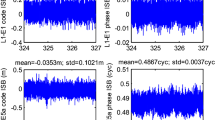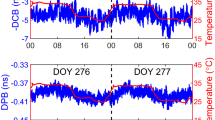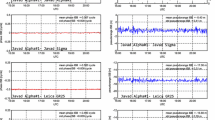Abstract
Global navigation satellite system operates using independent time scales and thus inter-system time offsets have to be determined to enable multi-constellation navigation solutions. GPS/Galileo inter-system bias and drift are evaluated here using different types of receivers: two mass market and two professional receivers. Moreover, three different approaches are considered for the inter-system bias determination: in the first one, the broadcast Galileo to GPS time offset is used to align GPS and Galileo time scales. In the second, the inter-system bias is included in the multi-constellation navigation solution and is estimated using the measurements available. Finally, an enhanced algorithm using constraints on the inter-system bias time evolution is proposed. The inter-system bias estimates obtained with the different approaches are analysed and their stability is experimentally evaluated using the Allan deviation. The impact of the inter-system bias on the position velocity time solution is also considered and the performance of the approaches analysed is evaluated in terms of standard deviation and mean errors for both horizontal and vertical components. From the experiments, it emerges that the inter-system bias is very stable and that the use of constraints, modelling the GPS/Galileo inter-system bias behaviour, significantly improves the performance of multi-constellation navigation.



















Similar content being viewed by others
References
Afifi A, El-Rabbany A (2015) An improved model for single-frequency gps/galileo precise point positioning. Positioning 6:7–21
Allan DW (1966) Statistics of atomic frequency standards. Proc. IEEE 54(2):221–230. doi:10.1109/PROC.1966.4634
Borio D, Gioia C, Mitchison N (2015) Identifying a low-frequency oscillation in Galileo IOV pseudorange rates. GPS Solut. doi:10.1007/s10291-015-0443-7
Bregni S (1997) Clock stability characterization and measurement in telecommunications. IEEE Trans Instrum Meas 46(6):1284–1294
Bregni S (2002) Synchronization of digital telecommunications networks. Wiley, New York
Brown RG, Hwang PYC (1996) Introduction to random signals and applied kalman filtering. Wiley, New York
Cernigliaro A, Valloreia S, Galleani L, Tavella P (2013) GNSS space clocks: performance analysis. In: Proceedings of the international conference on localization and GNSS (ICL-GNSS), pp 1–5 (2013). doi:10.1109/ICL-GNSS.2013.6577251
Dierendonck AJV, McGraw B, Brown RG (1984) Relationship between Allan variances and kalman filter parameters. In: Proceedings of the sixteenth annual precise time and time interval (PTTI) applications and planning meeting. Greenbelt, MD (1984)
European Union: European GNSS (Galileo) Open service signal in space interface control document. OS SIS IC 1.1, European Union (2010)
Gioia C (2014) GNSS navigation in difficult environments: hybridization and reliability. Ph.D. thesis, University Parthenope of Naples, Naples
Gioia C, Borio D, Angrisano A, Gaglione S, Fortuny J (2015) A Galileo IOV assessment: measurement and position domain. GPS Solut 19:187–199. doi:10.1007/s10291-014-0379-3
Gioia C, Pisoni F, Fortuny J: Estimation of the GPS to Galileo time offset and its validation on a mass market receiver. In: 7th ESA workshop on GNSS signals and signal processing (NAVITEC) (2014)
Hahn J (2013) Galileo and coordinated universal time leap seconds. ITU News
Hahn JH, Powers ED (2007) A report on GPS and Galileo time offset coordination efforts. Tech. report, joint 21st EFTF and FCS (2007)
Hewitson S, Wang J (2004) Impact of dynamic information on GNSS receiver integrity monitoring. In: International Symposium on GNSS/GPS. Sydney, Australia (2004)
International Committee on Global Navigation Satellite Systems : GNSS Timescale Description. Tech. rep., United Nations Office for Outer Space Affairs (2012)
Kaplan ED, Hegarty C (2005) Understanding GPS: principles and applications, 2nd edn. Artech House, Norwood
Klobuchar JA (1987) Ionospheric time-delay algorithm for single-frequency GPS users. Ionospheric time-delay algorithm for single-frequency GPS users. IEEE Trans Aerospace Electron Syst AES- 23(N. 3), 325–331 (1987)
Lindsey WC, Chie CM (1976) Theory of oscillator instability based upon structure functions. Proc. IEEE 64(12):1652–1666. doi:10.1109/PROC.1976.10408
Navstar GPS Directorate (2012) Global positioning systems directorate systems engineering & integration interface specification IS-GPS-200. Tech. rep, Navstar GPS Directorate
O’Driscoll C, Lachapelle G, Tamazin ME (2010) Investigation of the benefits of combined GPS/GLONASS receivers in urban environments. In: 5th ESA workshop on GNSS signals and signal processing, (NAVITEC). Royal Institute of Navigation, London (2010)
Parkinson B, Spilker J, Axelrad P, Enge P (1996) Global positioning system: theory and applications, vol I. American Institute of Aeronautics and Astronautics, Washington D.C
Paziewski J, Wielgosz P (2015) Accounting for Galileo-GPS inter-system biases in precise satellite positioning. J Geod 89:81
Piriz R, Mozo A, Tobias G, Fernandez V, Tavella P, Sesia I, Cerretto G, Hahn J (2008) GNSS interoperability: offset between reference time scales and timing biases. Metrologia 45:87–102
Sastamoinen J (1993) Contribution to the theory of atmospheric refraction, part II refraction correction in satellite geodesy. Bull Geod 107:13–34
U.S. Department of Defense, U.S. Department of Homeland Security and U.S. Department of Transportation: 2008 federal radionavigation plan (2008) Tech. rep., U.S. Department of Defense, U.S. Department of Homeland Security and U.S. Department of Transportation. DOT-VNTSC-RITA-08-02/DoD-4650.5 (2008)
Vanschoenbeek I, Bonhoure B, Boschetti M, Legenne J (2007) GNSS time offset effects on GPS-Galileo interoperability performance. Inside GNSS 5:60–70
Xu G (2003) GPS: theory. Algorithms and applications. Springer, Berlin
Author information
Authors and Affiliations
Corresponding author
Rights and permissions
About this article
Cite this article
Gioia, C., Borio, D. A statistical characterization of the Galileo-to-GPS inter-system bias. J Geod 90, 1279–1291 (2016). https://doi.org/10.1007/s00190-016-0925-6
Received:
Accepted:
Published:
Issue Date:
DOI: https://doi.org/10.1007/s00190-016-0925-6




